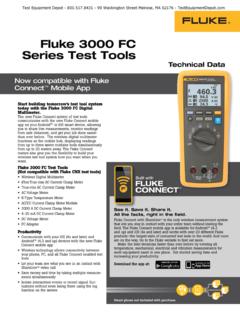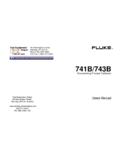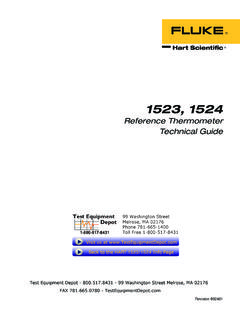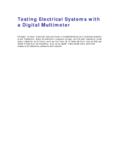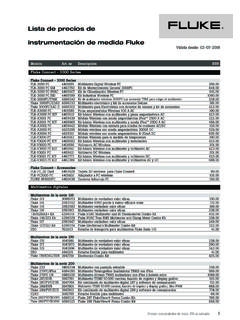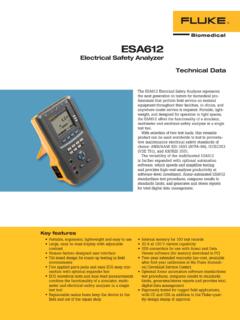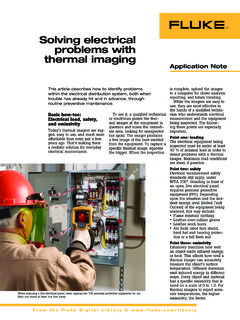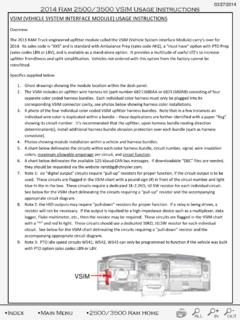Transcription of Insulation resistance testing - Test Equipment …
1 Insulation resistance testingIntroductionInsulation resistance testers can be used to determine the integrity of windings or cables in motors, transformers, switch-gear, and electrical installations. The test method is determined by the type of Equipment being tested and the reason for test-ing. For instance, when testing electrical cabling or switchgear (low-capacitance Equipment ) the time-dependent capacitive leakage and absorption leakage currents become insignificant and decrease to zero almost instantly. A steady conductive leakage current flow is reached almost instantly (a minute or less) providing perfect condi-tions for the spot-reading/short-time resistance test. (For more detailed information on leakage currents and resistance tests see the following sections: What Is Insulation resistance & Leak-age Currents and Predictive Maintenance Tests).
2 On the other hand, when the Equipment to be tested is a long run of cable, large motor, or generator (high-capacitance Equipment ) the time-depen-dent currents will last for hours. These currents will cause the meter readings to change con-stantly, making it impossible to obtain an accurate steady read-ing. This condition can be overcome by using a test that establishes a trend between readings, such as the step volt-age or dielectric-absorption test. These tests do not depend on a single reading but on a collection of relative readings. It would be a waste of time to perform these tests on low-ca-pacitance Equipment since the time-dependent currents dimin-ish quickly, resulting in all the measurements being the same. Installation testingThe most important reason for testing Insulation is to insure public and personal safety.
3 By performing a high dc voltage test between de-energized cur-rent-carrying (hot), grounded, and grounding conductors, you can eliminate the possibility of having a life-threatening short circuit or short to ground. This test is usually performed after the initial installation of the Equipment . This process will protect the system against miswired and defective equip-ment, and it will insure a high quality installation, customer satisfaction, and protect against fire or testingThe second most important rea-son for Insulation testing is to protect and prolong the life of electrical systems and mo-tors. Over the years, electrical systems are exposed to envi-ronmental factors such as dirt, grease, temperature, stress, and vibration. These conditions can lead to Insulation failure, result-ing in loss of production or even fires.
4 Periodic maintenance tests can provide valuable informa-tion about the state of deteriora-tion and will help in predicting possible failure of the system. Correcting problems will result not only in a trouble-free sys-tem, but will also extend the operating life for a variety of Note fluke Corporation Insulation resistance testingWork safelySafety is everyone s respon-sibility, but ultimately it is in your hands. No tool by itself can guarantee your safety. It is the combination of the instrument and safe work practices that gives you maximum protection. Here are a few safety tips you should follow: Work on de-energized circuits whenever possible. Use proper lock-out/tag-out procedures. If these proce-dures are not in place or not enforced, assume the circuit is live. On live circuits, use protective gear: Use insulated tools Wear flame resistant clothing, safety glasses, and Insulation gloves Remove watches or other jewelry Stand on an Insulation mat When making voltage mea-surements on live circuits: Hook on the ground clip first, then make contact with the hot lead.
5 Remove the hot lead first and the ground lead last. Hang or rest the meter if possible. Try to avoid holding it in your hands to minimize personal exposure to the effects of transients. Use the three-point test method, especially when checking to see if a circuit is dead. First, test a known live circuit. Second, test the target circuit. Third, test a live circuit again. This verifies that your me-ter worked properly before and after the measure-ment. Use the old electricians trick of keeping one hand in your pocket. This less-ens the chance of a closed circuit across your chest and through your heart. When performing Insulation and resistance tests: Never connect the insula-tion tester to energized conductors or energized Equipment and always follow the manufacturer s measuringIn order to obtain meaningful Insulation resistance measure-ments, the electrician should carefully examine the system under test.
6 The best results are achieved when:1. The system or Equipment is taken out of service and disconnected from all other circuits, switches, capacitors, brushes, lightning arrestors, and circuit breakers. Make sure that the measurements are not affected by leakage current through switches and overcurrent protective devices.. The temperature of the con-ductor is above the dew point of the ambient air. When this is not the case, a moisture coating will form on the in- Shut down the Equipment to be tested by opening fuses, switches, and circuit breakers. Disconnect the branch cir-cuit conductors, grounded conductors, grounding conductors, and all other Equipment from the unit under test. Discharge conductor capacitance, both before and after the test. Some instruments may have automatic discharge functions.
7 Check for any leakage current through fuses, switches, and breakers on de-energized circuits. Leakage current can cause inconsistent and incorrect readings. Don t use an Insulation tester in a dangerous or explosive atmosphere since the instrument can generate arcing in dam-aged Insulation . Use insulated rubber gloves when connecting the test surface, and, in some cases will be absorbed by the material. 3. The surface of the conductor is free of carbon and other foreign matter that can be-come conductive in humid Applied voltage is not too high. When testing low- voltage systems; too much voltage can overstress or damage Insulation . 5. The system under test has been completely discharged to the ground. The ground-ing discharge time should be about five times the testing charge The effect of temperature is considered.
8 Since Insulation resistance is inversely propor-tional to Insulation tempera-ture ( resistance goes down as temperature goes up), the recorded readings are altered by changes in the temperature of the insulating material. It is recommended that tests be performed at a standard conductor temperature of 0 C (68 F). As a rule of thumb, when comparing read-ings to 0 C base tempera-ture, double the resistance for every 10 C (18 F) above 0 C or halve the resistance for every 10 C below 0 C in temperature. For example, a one-megohm resistance at 40 C (104 F) will translate to four-megohm resistance at 0 C (68 F). To measure the conductor temperature, use a non-contact infrared ther-mometer such as the fluke fluke Corporation Insulation resistance testingWhat are Insulation resistance and leakage currents?
9 During the testing procedure, the high dc voltage generated by pressing the test button will cause a small (micro-amps) cur-rent flow through the conductor and the Insulation . The amount of current depends on the amount of voltage applied, the system s capacitance, the total resistance , and the tempera-ture of the material. For a fixed voltage, the higher the current, the lower the resistance (E=IR, R=E/I). The total resistance is the sum of the internal resis-tance of the conductor (small value) plus the Insulation resis-tance in M s. Figure 1. Current componentsTotal Current(IA + IC + IL)Time(in seconds)0 Current(in A)InsulationResistance(in Megohms)ILICIAF igure . Conductive leakage current (IL)ILConductorsDielectricInsulationFigu re 3. Capacitive charging leakage current (IC)ICConductorsDielectricInsulationThe value of Insulation re-sistance read on the meter will be a function of following three independent sub-currents.
10 Conductive leakage current (IL)Conductive current is a small (micro-amp) amount of current that normally flows through Insulation , between conductors or from a conductor to ground. This current increases as insula-tion deteriorates and becomes predominant after the absorp-tion current (see Figure 1) van-ishes. Because it is fairly steady and time independent, this is the most important current for measuring Insulation resistance . Capacitive charging leakage current (IC)When two or more conductors are run together in a raceway, they act as a capacitor. Due to this capacitive effect, a leakage current flows through conduc-tor Insulation . This current lasts only for a few seconds as the dc voltage is applied and drops out after the Insulation has been charged to its full test voltage. In low-capacitance Equipment , the capacitive current is higher than conductive leakage cur-rent, but usually disappears by the time we start recording the data.

